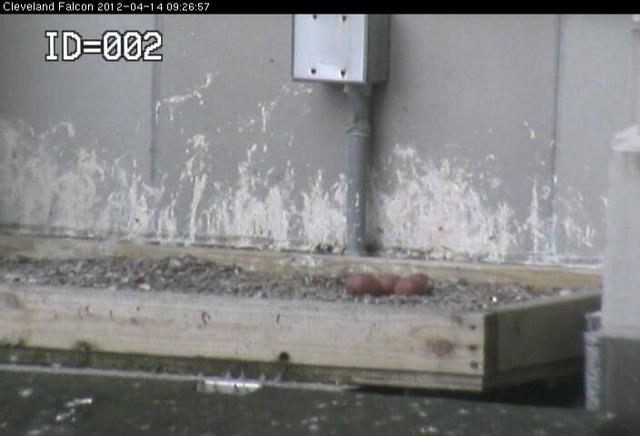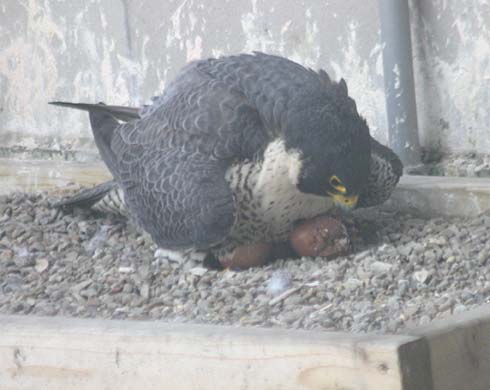FALCON FLASH
Dateline: Cleveland, Ohio
April 18, 2012
Click here to read what happened earlier
Yesterday, Mr. Wright returned to watch and reported, “The egg that is hatching looked all mangled on one end, but I did see a chick inside moving about”. Mr. Wright describes what the hatching egg looked like in person:
“How can I describe the shell? Let’s say when you have a hard boiled egg and you have cracked it, but the inner membrane of the egg is hard to break through, that is what one side of the egg looked like. Small pieces of egg shell all cracked but still held together by the inner membrane.”
After what seems to be a very long time, no little falcon has hatched out from the first egg. We will have to wait and see whether the little guy will make it. Hatching is very hard work and the parents do not assist. Mr. Wright reports a second egg has pipped and cracked, so we hope that hatch will proceed normally.
Watch closely at: http://www.falconcam-cmnh.org/news.php
Our thanks to the Cleveland Museum of Natural History for sponsoring the FalconCams and for the still.
Photos are courtesy of Scott Wright. They may be used in any non-commercial publication, electronic or print, but please give photo credit.
A possible hatch has been taking place for days, but the length of time it is taking is a worry. Falcon fans have been waiting and straining their eyes as they watch the FalconCams. Was that a pip in one egg 4 days ago?
Volunteer monitor, Mr. Scott Wright, has spent many hours at the nestsite the last few days watching the hatch. At first all seemed normal, and he reported that SW sat high on the eggs with back arched to let some heat escape, and the parents listened throughout.
He reported that there was indeed a pip, and in fact the shell was cracked.
Mr. Harvey Webster, Director of Wildlife Resources at the Cleveland Museum of Natural History tells us: “Pipping is the act of creating a breach in the shell and shell membrane so that the chick can establish respiratory function. After the pip there is a quiet phase where the chick draws blood back into its body from the shell membrane.
Once complete, the chick will then vigorously score the inside of the shell with its egg tooth while simultaneously pushing against the blunt cap of the egg with its neck. After scoring the shell for two thirds of its circumference the chick pushes against the cap and it flexes back enough for the chick to push its way out. It generally takes 24-36 hours between the onset of the pip and actual hatching”.
In the following picture taken on Monday, you can see the cracked egg - and possibly what’s inside pushing against the shell.
Click here to read what happened next



